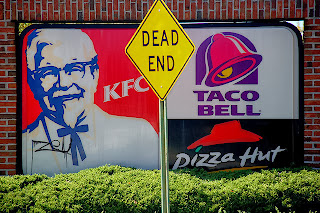"Warning: May contain a slurry of scraps off the slaughterhouse floor, washed with ammonia." A label that appears on no burger, by USDA decree.
If you haven’t heard of it, “lean finely textured beef” is big business. As the Young Turks explain, “lean finely textured beef,” or LFTB, is made of a slurry of scraps off the slaughterhouse floor and enough ammonia to kill the bacterial nastiness with which its imbued. McDonald’s and most other fast food chains were using this mechanically extracted, nutritionally weak filler in their American “all beef” burger patties, until Jamie Oliver ignited a consumer backlash. Until this point, the food industry lobby vigorously defended the practice of secretly including "pink slime" in ground beef patties and taco fillings, and was supported by the FDA, which still does not require the ingredient to be disclosed.Where in previous decades, American beef was consonant with luxury---the Japanese word for steak is “bifusteku”---today, our use of LFTB has spoiled the image of American beef abroad. In East Asia, signs in American fast food chains proudly proclaim, “No US beef” in their products. Meanwhile in the US, “pink slime” is unavoidable to the average, thrifty consumer. Though restaurant chains have been quick to announce when they've discontinued using LFTB, it’s still found---unlabeled---in restaurant fare and institutional food, including school lunches.
Cooking at home is no guarantee you’ll avoid “pink slime,” either, because LFTB may be sold at your grocery store, where it may constitute up to 15 percent of ground beef without being labeled as containing anything other than plain old ground beef. In agreement with Jamie Oliver, Colleen Vanderlinden at TLC Cooking says we are “literally eating garbage” when we eat this stuff. Instead of calling drive through burgers “fast food,” we should be calling it “trash food.”
Image credit: felixtriller./Flickr

